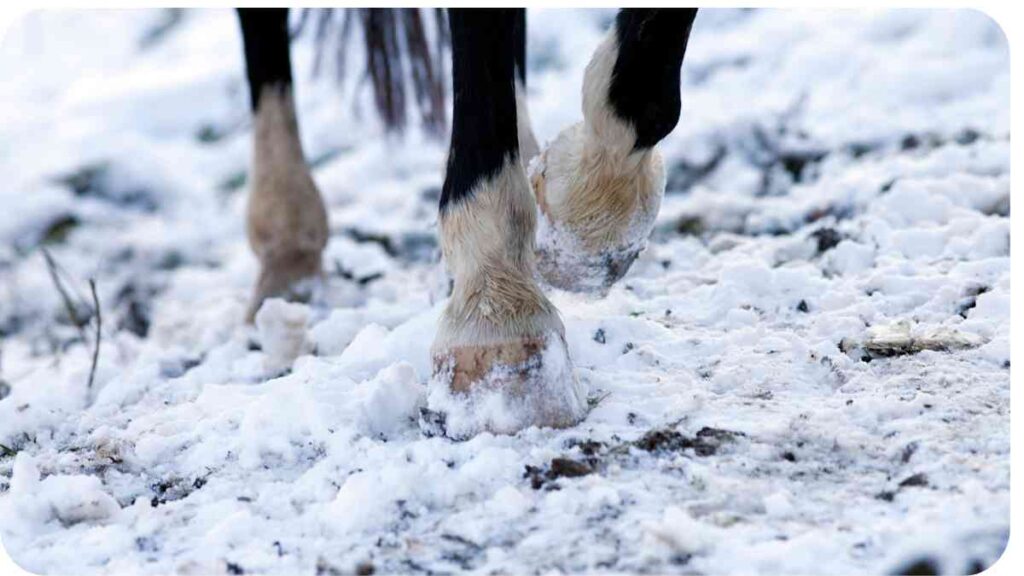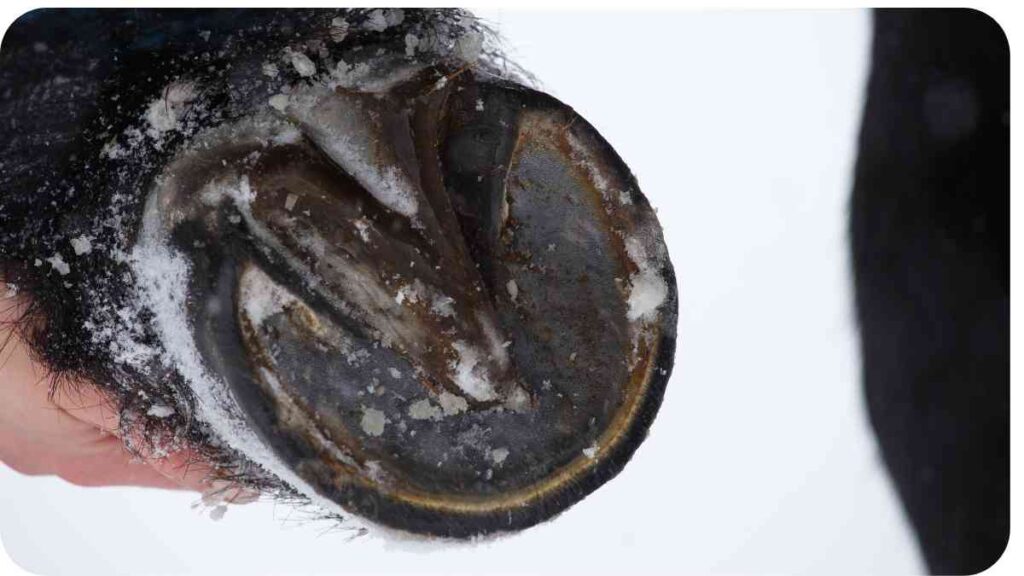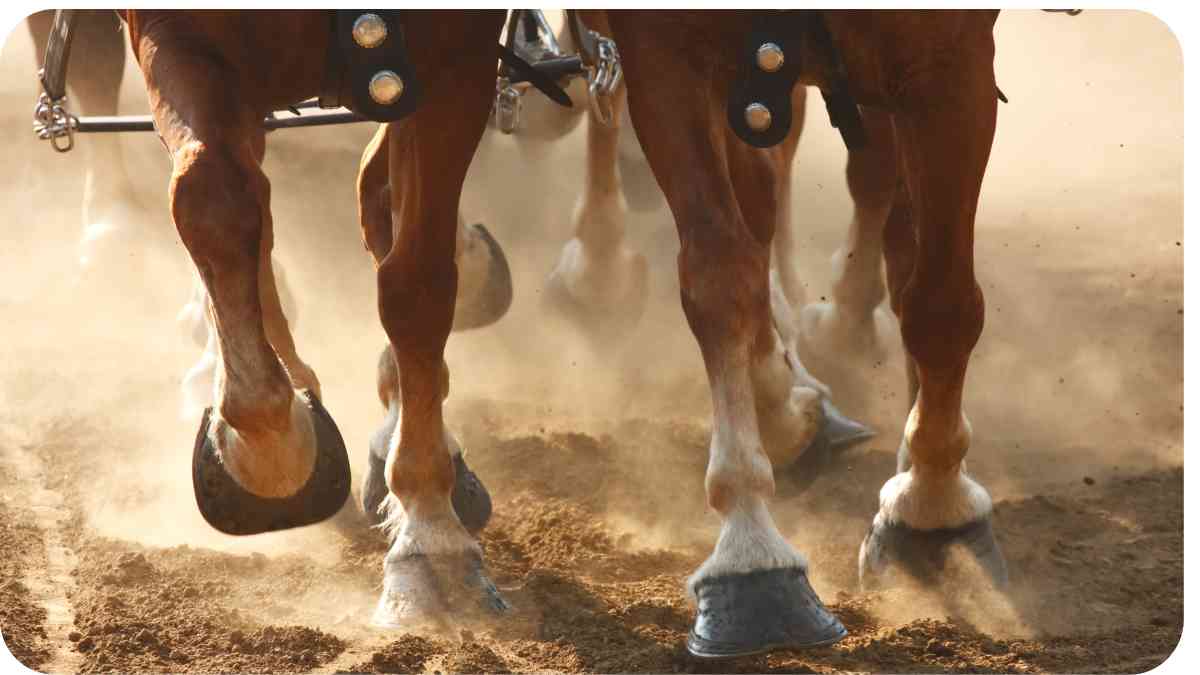When it comes to caring for your horse’s hooves, there has been a growing debate about whether going barefoot is a better alternative to traditional shoeing. Barefoot hoof care has gained popularity among many horse owners and hoof care professionals.
In this article, we will explore the pros and cons of barefoot hoof care, helping you make an informed decision for your equine companion.
| Takeaway |
| Barefoot hoof care offers benefits such as natural shock absorption, improved circulation, and stimulated hoof function. |
| Transitioning to barefoot hoof care requires a gradual and careful process, including regular trimming and appropriate exercise. |
| Maintaining a balanced diet with essential nutrients is crucial for healthy barefoot hooves. |
| While barefoot hoof care has advantages, it’s important to be aware of potential drawbacks, such as sensitivity to certain terrains. |
| Finding a knowledgeable and experienced professional hoof care provider is essential for successful barefoot hoof care. |
Understanding the Horse’s Hooves
To comprehend the importance of barefoot hoof care, it’s crucial to understand the structure and function of a horse’s hooves. The equine hoof is a complex and fascinating mechanism that supports the horse’s entire body weight. By providing a sturdy foundation, healthy hooves contribute to the overall well-being and soundness of the horse.
Table: Comparison of Shod vs. Barefoot Hooves
| Aspect | Shod Hooves | Barefoot Hooves |
| Flexibility | Restricted due to the presence of horseshoes | Natural flexibility allows for shock absorption |
| Traction | Increased due to shoe design | Determined by the quality of the hoof and terrain |
| Circulation | Hindered circulation due to shoe constriction | Improved blood flow due to better hoof function |
| Natural Wear | Reduced due to shoe protection | Allows for natural wear and self-trimming |
| Cost | Initial investment in shoes and regular maintenance | Generally cost-effective long-term |
The Benefits of Barefoot for Horses

Opting for barefoot hoof care can offer several advantages to horses. By allowing the hooves to remain in their natural state, barefoot advocates argue that the following benefits can be achieved:
When considering horse footwear, properly fitting boots are vital. Ill-fitted boots can lead to discomfort and injury, which parallels the discussion of barefoot versus shod horses, where comfort plays a crucial role.
Table: Key Advantages of Barefoot Hoof Care
| Benefit | Description |
| Natural Shock Absorption | Maximized through the hoof’s flexibility and self-trimming |
| Improved Blood Circulation | Enhanced by unrestricted blood flow through healthy hooves |
| Increased Traction | Natural surface grip and adaptability to various terrains |
| Stimulated Hoof Function | Hooves develop strength and resilience through movement |
| Reduced Risk of Infections | Proper hoof hygiene and natural defense mechanisms |
Potential Drawbacks of Barefoot Hoof Care
While barefoot hoof care has its benefits, there are potential drawbacks to consider as well. It’s essential to be aware of these aspects to make an informed decision for your horse’s hoof care:
Table: Disadvantages of Barefoot Hoof Care
| Drawback | Description |
| Sensitivity to Hard Surfaces | Hooves can be more sensitive on rocky or hard terrain |
| Transition Period | Adjustment time required during the transition from shod to barefoot hooves |
| Potential for Overwear | Excessive wear on hooves if ridden on abrasive surfaces without proper conditioning |
| Limited Protection | Hooves may be less protected from certain injuries and environmental factors |
| Not Suitable for All Horses | Some horses with specific hoof conditions may require specialized care |
Transitioning to Barefoot
If you’re considering transitioning your horse to barefoot hoof care, it’s essential to follow a gradual and careful process. Here are some steps to facilitate a smooth transition:
Selecting the right saddle is essential for your horse’s well-being. The saddle’s fit and design influence the horse’s comfort and health, making it a key factor in the debate of barefoot versus shod horses
Table: Steps for Transitioning to Barefoot Hoof Care
| Step | Description |
| Evaluate Hoof Health | Assess the current condition of your horse’s hooves |
| Regular Trimming | Establish a consistent trimming schedule to gradually encourage hoof growth |
| Manage Environment | Provide an appropriate living environment suitable for a barefoot horse |
| Exercise | Gradually increase exercise levels to |
gradually increase exercise levels to help promote healthy hoof development and strengthen the hooves.
Table: Steps for Transitioning to Barefoot Hoof Care
| Step | Description |
| Monitor Progress | Regularly observe your horse’s hooves during and after the transition phase |
| Seek Professional Guidance | Consult with a knowledgeable hoof care professional for guidance and support |
| Adjust as Needed | Make adjustments to the transition plan based on your horse’s individual needs |
Tips for Maintaining Healthy Barefoot Hooves

Once your horse has successfully transitioned to barefoot hoof care, it’s vital to maintain their hooves’ health. Here are some tips to help you ensure optimal hoof condition and function:
Good dental care is paramount for maintaining equine health. Healthy teeth are crucial for a horse’s overall well-being, drawing a parallel to the discussion of barefoot horses and their health.
Table: Tips for Optimal Barefoot Hoof Health
| Tip | Description |
| Consistent Trimming | Schedule regular trims to maintain the proper hoof length and balance |
| Balanced Diet | Provide a well-rounded diet with adequate nutrients for healthy hoof growth |
| Regular Exercise | Engage your horse in regular exercise to stimulate hoof development and strength |
| Environmental Considerations | Monitor hoof exposure to wet and dry conditions to prevent imbalances |
| Hoof Protection | Use hoof boots or other protective measures when necessary to prevent injuries |
The Role of Diet in Hoof Health
A horse’s diet plays a significant role in maintaining healthy hooves. Providing the necessary nutrients can enhance their hoof quality and overall well-being. Here are some essential nutrients to prioritize:
Equine colic can be a severe threat to your horse’s health. Understanding and preventing colic is essential for your horse’s welfare, mirroring the concern for horse health in the barefoot versus shod debate.
Table: Essential Nutrients for Healthy Hooves
| Nutrient | Description |
| Biotin | Supports hoof strength and growth, commonly found in quality hoof supplements |
| Omega-3 Fatty Acids | Promote hoof moisture and flexibility, present in flaxseed or fish oil |
| Zinc | Plays a crucial role in keratin production, important for hoof strength |
| Copper | Supports collagen cross-linking and hoof tissue elasticity |
| Methionine | Amino acid necessary for keratin synthesis, found in high-quality protein sources |
Common Hoof Problems and How to Address Them
Even with attentive care, horses can still experience various hoof problems. Understanding these issues and knowing how to address them is essential for maintaining your horse’s hoof health. Here are some common problems and potential solutions:
Table: Solutions for Common Hoof Issues
| Hoof Problem | Solution |
| Hoof Cracks | Regular trimming and appropriate hoof moisturization |
| Thrush | Regular cleaning, applying medicated solutions, and improving hoof hygiene |
| White Line Disease | Proper trimming, treating the affected area with antifungal agents, environmental management |
| Bruised Soles | Providing supportive hoof boots and applying sole packing when necessary |
| Laminitis | Prompt veterinary intervention, appropriate dietary adjustments, and proper hoof care |
Finding the Right Professional Hoof Care Provider
When it comes to barefoot hoof care, it’s crucial to work with a knowledgeable and experienced professional. Finding the right hoof care provider goes a long way in ensuring your horse’s hoof health. Consider the following factors when making your selection:
Effective ground work is integral to horse training and well-being. Groundwork builds trust and obedience in horses, aligning with the importance of considering barefoot horses in the broader context of their overall health.
Table: Factors to Consider When Choosing a Hoof Care Professional
| Factor | Description |
| Certifications/Qualifications | Look for certifications and qualifications indicating expertise in barefoot hoof care |
| Experience | Inquire about the professional’s experience in working with barefoot horses |
| References/Reviews | Seek recommendations and reviews from other horse owners who have used their services |
| Approach | Discuss their approach to hoof care and ensure it aligns with your goals and values |
| Continued Education | Evaluate their commitment to staying updated with the latest advancements in hoof care |
Conclusion
In conclusion, deciding whether barefoot hoof care is better for your horse requires careful consideration of the pros and cons. While barefoot care offers advantages such as natural shock absorption, improved circulation, and stimulated hoof function,
it also comes with certain drawbacks. By following proper transitioning methods, practicing regular maintenance, and providing a well-rounded diet, you can ensure the best hoof health for your equine companion.
Remember to consult with a knowledgeable hoof care professional and monitor your horse’s progress closely throughout the transition and beyond. With the right approach and attention, barefoot hoof care can contribute to the overall well-being and soundness of your horse.
Further Reading
Here are some additional resources for further reading on the topic of barefoot hooves and horseshoeing:
- Why Do Horses Need Shoes? A Horse Shoeing Guide: This comprehensive guide explores the reasons behind the traditional use of horseshoes and provides insights into the benefits they offer.
- Shoeing vs. Barefoot: What’s Best for Your Horse?: This blog post dives into a detailed comparison between shoeing and barefoot hoof care, discussing the pros and cons of each approach.
- Pros and Cons of Going Barefoot – Dawn Champion’s Scoot Boots Journey: This article features the personal journey of Dawn Champion and her experience transitioning to barefoot hoof care using Scoot Boots. It highlights the specific pros and cons she encountered along the way.
FAQs
Here are some frequently asked questions about barefoot hoof care:
What is barefoot hoof care?
Barefoot hoof care refers to the practice of keeping a horse’s hooves in their natural, unshod state. It involves regular trimming, proper nutrition, and maintaining optimal hoof health without the use of horseshoes.
Is barefoot hoof care suitable for all horses?
While barefoot hoof care can be beneficial for many horses, it may not be suitable for all. Some horses with specific hoof conditions or performance requirements may require specialized hoof care or the use of shoes.
How long does it take for a horse to transition to barefoot hooves?
The transition period to barefoot hooves can vary depending on the individual horse and its current hoof condition. It typically takes several months for the hooves to adapt and strengthen, but each horse’s journey is unique.
How do I know if my horse’s hooves are healthy?
Healthy hooves have a good shape and balance, appropriate hoof length, and no signs of cracks, thrush, or other issues. Regular observation, hoof cleaning, and working with a professional can help ensure your horse’s hooves stay healthy.
Can I ride my horse barefoot on any terrain?
While barefoot hooves are naturally adaptable, some terrains may pose challenges, such as rocky or hard surfaces. It’s recommended to evaluate the terrain and use protective hoof boots when necessary to ensure your horse’s comfort and safety.

Hi there! My name is Hellen James, and I’m a horse riding expert. I’ve been riding horses since I was just a kid—and it’s been my passion ever since. But getting started with horse riding can be overwhelming. There’s so much to learn! If you’re looking for a way to get started and make sure you’re doing it right, I’m here to help.


